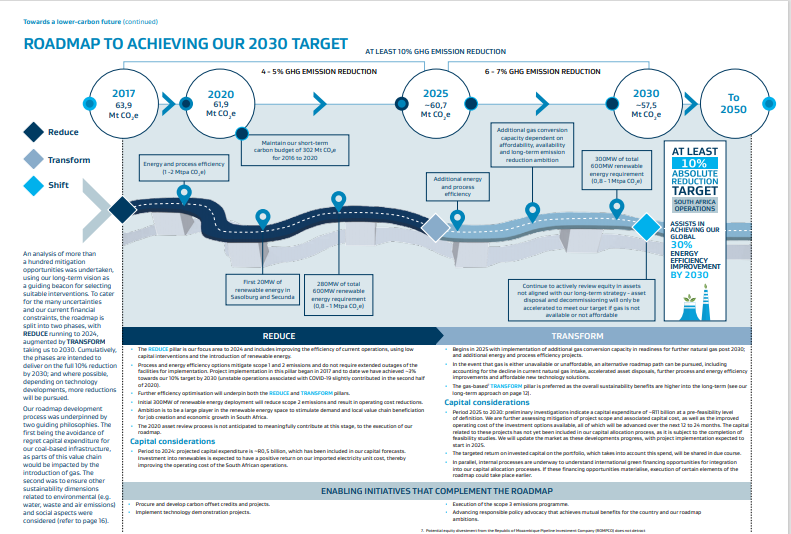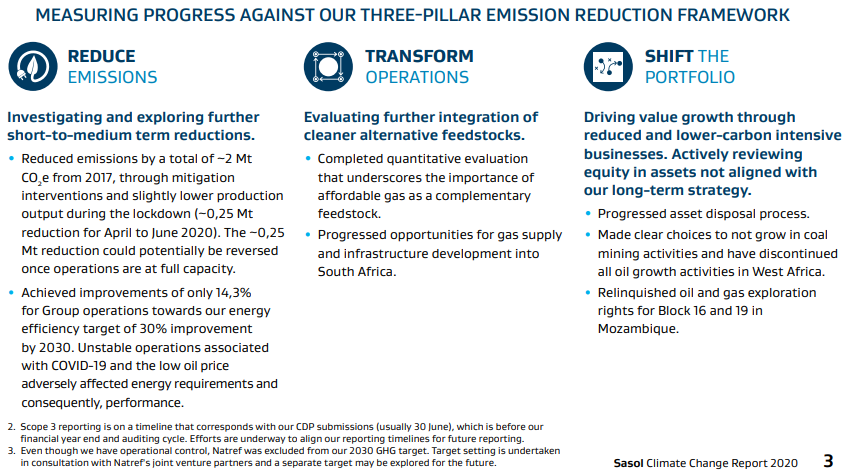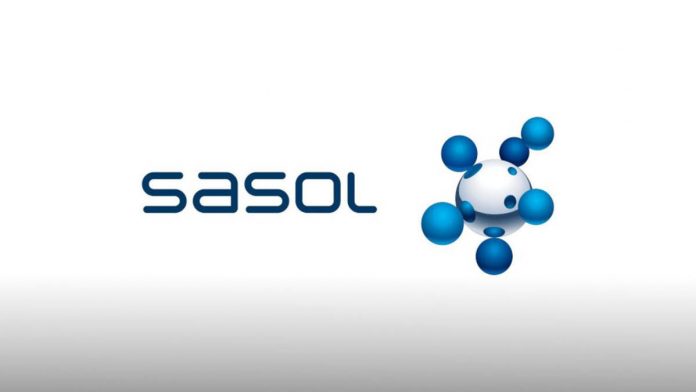In a virtual media roundtable, Sasol engaged and gave feedback on the release of their recent Sasol Limited Climate Change Report.
The report states the following: “Sasol’s 2030 roadmap is based on an ambition for a significantly transformed energy profile in South Africa by 2050. Delivering on our 2030 target through our roadmap is a key milestone for greater reductions into the future and to building the long-term resilience of our operations. Our three-pillar emission reduction framework forms the basis for us to transition.”

Sasol’s three-pillar emission reduction framework is based on: Reduce Emissions, Transform Operations and Shift the Portfolio.

Some key points in the Climate Change Report are:
- In the report Sasol states that they are “keen to play a leadership role in South Africa’s energy transition.”
- A “Roadmap for achieving our 2030 target” is set out. In 2019, the target was set to reduce Greenhouse Gas (GHG) emissions by at least 10% for South African operations off their 2017 target of 63,9Mt CO2e. This target does not align with the Paris Agreement but is “based on the probability of success of potential reduction opportunities, associated risks, economic viability and balance sheet capability to finance these activities”. Sasol also said that it is “in the process of defining a 2050 reduction ambition and roadmap”. This will be communicated at the Capital Markets Day in 2021. (The Paris Agreement is explained later in this article.)
- This is Sasol’s plan to reduce emissions: energy and process efficiency, the introduction of renewable energy, asset disposals and the replacement of coal with natural gas as a feedstock for the liquid fuel business.
- Sasol is relying on the notion that by 2030 natural gas resources and infrastructure will be available.
- Sasol’s scope 3 emissions were assessed and in 2019 they estimated emissions at 42,3Mt CO2e or 39% of total GHG emissions.
Although there was a reduction of emissions during the national lockdown, Sasol said that it can be reversed once operations return to full capacity after the lockdown.
During an interview with Sarushen Pillay, Vice President: Environmental Sustainability and Shamini Harrington, Vice President: Climate Change, I asked them key questions that align with the report released.
- In the Sasol of the future, what are the strategic shifts planned in terms of environmental issues specifically for the South African operating entities regarding Sasol’s reduction of carbon footprint.
Shamini answered:

“For future Sasol we reset our strategy, there were a number of areas to look at. Of course, now the financial situation, looking at the low oil price post Covid but also at the heart of this was Climate Change and the impact of Climate Change in the future in terms of risks related to regulatory high carbon pricing.
What we did was reanalyse our previous structure and we looked at how robust this strategy is in a Paris aligned temperature goal.
What we found was that our coal value chain, specifically, was not resilient and we found that the earnings impact was quite large, greater than 50 % on the Paris Agreement aligned goal.
We looked at how we could update our strategy in order to incorporate a reduction target, which is the 2030 target, at least 10% reduction of our 2017 baseline.
Over and above working towards the 2030 target, we have also put in place a 2050 production target as well as a 2050 Roadmap.
That is framed against our three-pillar reduction framework.
By doing that the key opportunities for future Sasol is renewable energy deployment, growing that sector and utilising the power as well as looking at gas at an alternative feedstock for ourselves and also the benefit of gas in the South African economy.
Also, the big opportunity around green hydrogen and positioning for this big opportunity globally and marketing ourselves as a producer of green hydrogen.”
Sarushen jumped in at this point and explained more about green hydrogen:

“The opportunity for green hydrogen starts with our journey on renewables. We see significant potential to take with South Africa’s renewable resources.
Wind and solar resources lay a foundation for a transition for us to become a producer in green hydrogen.
The 600MW of renewable energy that we recently procured, was the first step. Part of that, we will be looking for two imbedded generation projects; 1 in Secunda and 1 in Sasolburg. We see that as a springboard to become a producer in green hydrogen.
The key to unlocking green hydrogen is for renewable energy costs to decrease and secondly for the actual cost of the electroliers to decrease.
2. In terms of allocated carbon credits, is Sasol aiming to buy out more carbon credits from other companies or does Sasol intend to reduce their current credits in the long term?
(A carbon credit is a permit that allows the company that holds it to emit a certain quantity of carbon dioxide or other greenhouse gases. One credit permits the emission of a mass equal to one ton of carbon dioxide.)
READ ALSO: DA retains ward with landslide victory
Shamini:
“What we are trying to do is to apply a carbon offset strategy. The carbon offset strategy we have in place is to reduce through carbon credits and procuring through other players in the market.
We are also looking at codeveloping projects to generate credits with experienced project developers. In the long term we are looking in developing our own projects.
We apply a carbon management hierarchy and that is focussing on reducing emissions on our scope, our scope 1 and scope 2 emissions.
Now, in the South African economy we have what is called the Carbon Tax Act. This allows for carbon offsetting to a certain percentage. We are utilising, for the next for years, the mechanism provided by government in order to offset our carbon emissions related to the Carbon Tax Act.
We do see it changing after time but we do see it changing over time to address our residual emissions after mitigation.
3. What technologies are being looked at to reduce Sasol’s carbon footprint?
Sarushen:
“There are a number of technology areas that we considering but we really see the potential for new technology breakthroughs post the 2030 timeframe.
I’ll list a few areas where we see quite significant promise.
The first is the combination of renewable energy plus energy storage. We want to try maximise the usage of renewable energy, as we see those cost dropping.
We also see energy storage costs significantly dropping and at the scale at which renewable energy is being stored, we are seeing plants that up to a 100 MW scale globally and see Sasol to jump on that and take advantage. That will maximise our intake of renewable energy.
The second area is CO2e utilisation. At Secunda and Sasolburg we produce concentrated streams of CO2. We capture these streams and recurrently release them but we have some of the largest CO2 capture plants globally.
We are looking at converting this CO2 into fuels and other chemical products, like fertilisers and this is really the area where we se potential.
There is also quite an interest globally to combine CO2 and green hydrogen and convert it into jet fuel. The technology that is used to do that is called Ficher-Tropsch technology and Sasol is the world leader in this technology.
The last technology area we are looking at and see big promises is green hydrogen. The production of hydrogen in Secunda is responsible for half of our emissions and if we can get green hydrogen that would go a long way in reducing our emissions in Secunda.
4. Please explain the Paris Agreement, should someone not be familiar with the agreement.
Shamini:
“The Paris Agreement is a global agreement that aims to limit temperature increases to well below 2 Degrees Celsius and pushing to efforts for 1.5 Degrees efforts.
It is a global agreement that which is enshrined within the United Nations (UN) framework convention on Climate Change. And what that is, is the authority in terms of managing Climate Change at a global level.
The Paris Agreement brings all of the parties to the UN together (192 parties) and asked them to sign up and conform to the requirements of keeping temperature to well below 2 Degrees Celsius.
To support that there are different scientific bodies, the key body is the Inter-Governmental Panel on Climate Change.
What they detail at a global level is what the emission reduction target should be for 2030, 2050 and moving toward 2100.
An interesting thing about the Paris Agreement is because it is enshrined in the UN Framework Convention on Climate Change is that it actually looks at how different parties should play a role.
Not every country has the same development status and circumstances. Their expectation in the Paris Agreement is that developed countries must lead the way and they must take on more aggressive targets while developing countries must also take action but there is recognition that they might be on a different trajectory.
In the South African context that means that we are a developing country. Even though we are a developing country, we do have large emissions and there is a need for us to act. We cannot ignore the important issues of social upliftment, poverty and alleviation, unemployment, economic growth and sustainable growth.
So, by carving out our targets and the approaches we take, these nuances and these key challenges must be factored in, in terms of timing and reduction targets put in place because climate change is everything to do about economics and development issues and less about environmental.”
READ ALSO: SASOL LIMITED CLIMATE CHANGE REPORT

